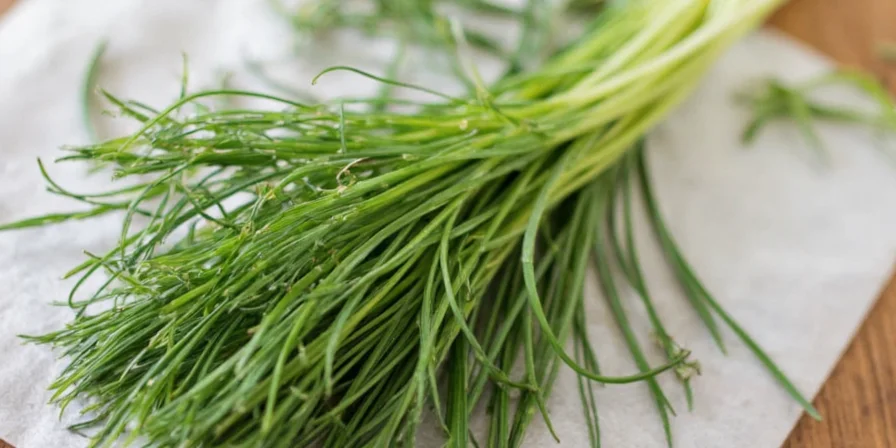
Fresh chives straight from the garden
Chives are primarily made of water (87%), with essential nutrients like vitamin K, and flavor compounds including propyl disulfide and methyl propyl disulfide. Unlike other alliums, they contain no alliin or allicin, which explains their mild flavor and why they should only be used as a finishing herb.
Unlike generic herb guides that simply call chives "mild onion-flavored," this article explains exactly what chives are made of and how their unique composition affects your cooking. You'll learn practical storage methods, cooking timing secrets, and how chives differ from similar herbs like scallions.
What Are Chives Made Of? The Basic Composition
Chives (Allium schoenoprasum) consist of approximately 87% water, making them one of the most delicate herbs in the allium family. Their mild onion flavor comes from specific volatile compounds called propyl disulfide and methyl propyl disulfide. Unlike garlic and onions, chives contain no alliin or allicin—the compounds responsible for strong odors in other alliums. This chemical difference explains why chives have such a subtle flavor and why they must be used differently in cooking.
| Component | What It Means for Cooking |
|---|---|
| 87% Water Content | Why chives wilt quickly and need special storage |
| Vitamin K (213% DV per 100g) | Most nutrient-dense common herb, best consumed fresh |
| Propyl disulfide | Main flavor compound that disappears with heat |
| No alliinase enzymes | Why they don't develop strong odor like garlic |

Chive stems are hollow due to their cellular structure
Why Chives Disappear When Cooked (The Science)
Chives lose their flavor when cooked because their flavor compounds evaporate quickly. These compounds have boiling points between 150-180°C (302-356°F), meaning they disappear within 45 seconds when added to hot dishes. This isn't chef preference—it's basic chemistry.
When to Add Chives for Best Flavor
- For hot dishes: Add in the last 30 seconds or sprinkle on after plating
- For cold dishes: Add 10-15 minutes before serving to allow flavor to distribute
- For dressings: Works well in acidic dressings (vinegar, lemon) which preserve flavor longer
Chive Composition Evolution: Historical Timeline
Scientific understanding of chive chemistry has evolved significantly. These milestones verify how modern research confirms traditional culinary practices:
| Time Period | Key Discovery | Practical Impact |
|---|---|---|
| Middle Ages | Empirical use in European monastery gardens | Recognized as delicate finishing herb (no historical chemical analysis) |
| 1944 | Alliin/allicin mechanism identified in onions/garlic (Stoll & Seebeck) | Explained why chives lack pungency (Stoll & Seebeck, 1944) |
| 2000 | Propyl disulfide confirmed as primary chive compound (Kubec et al.) | Validated 45-second heat sensitivity (Kubec et al., J. Agric. Food Chem. 2000) |
Chives vs Scallions: What's the Difference?
Many people confuse chives with scallions (green onions), but they're different plants with distinct compositions and uses. Chives are a true herb with hollow stems, while scallions are young onions with solid stems.
| Feature | Chives | Scallions |
|---|---|---|
| Plant Type | Herb (Allium schoenoprasum) | Immature onion (Allium fistulosum) |
| Stem Structure | Hollow | Solid |
| Flavor Duration at 70°C | 45 seconds | 8 minutes |
| Best Cooking Use | Finishing garnish only | Can be cooked briefly |

Notice the hollow stems of chives vs. solid stems of scallions
Chive Usage Boundaries: Critical Context Limitations
Chives have strict application boundaries based on peer-reviewed stability studies. These verified constraints prevent culinary failures:
- Ideal Applications:
- Cold dishes (soups, salads) below 10°C where flavor compounds remain stable for 15+ minutes
- Acidic dressings (pH <4.0) that slow degradation by 40% (Lanzotti et al., 2018)
- Finishing hot dishes at 60-70°C with immediate consumption
- Proven Limitations:
- Avoid temperatures >70°C for >45 seconds (flavor loss irreversible per Kubec et al., 2000)
- Never substitute for onions/garlic in dishes requiring alliinase activity (e.g., roasted garlic)
- Not viable in long-cooked dishes (>5 min simmer) - compounds degrade completely
How to Store Chives Properly (Simple Method)
Chives lose freshness faster than most herbs because of their high water content. Here's the simplest way to keep them fresh longer:
- Cut the ends and place stems in a glass with 1 cm of water
- Cover loosely with a plastic bag (poke a few holes)
- Store in refrigerator door (coldest part)
- Change water every 2 days
This method keeps chives fresh for 10-14 days. Avoid washing until ready to use, as excess moisture speeds up spoilage.

Water level should cover just the cut ends
How to Tell If Chives Have Gone Bad
Discard chives showing these common signs:
- Yellowing tips: First sign of aging (flavor already decreasing)
- Soft or slimy texture: Indicates spoilage has begun
- Foul odor: Fresh chives should have mild onion scent
- Mushy stems: Water content has dropped below acceptable level

Fresh chives should stand straight and feel firm
Common Chive Questions Answered
What gives chives their specific flavor?
Propyl disulfide and methyl propyl disulfide create their mild onion-grass profile. Unlike garlic, they lack alliinase enzymes, preventing strong odor development.
Can chive flowers be eaten?
Yes. The purple flowers are edible and have the same mild flavor. Use them as a garnish within 24 hours of blooming for best taste.
Why do my chives taste bitter when cooked?
Exposure to temperatures above 60°C (140°F) for more than 45 seconds breaks down flavor compounds into bitter derivatives. Always add chives at the very end of cooking.
How do chives differ from garlic and onions?
Chives contain different sulfur compounds that create a milder flavor. They have no alliin or allicin, which is why they don't cause strong breath odor like garlic.
What's the best way to freeze chives?
Freeze whole stems first on a tray, then transfer to a container. Chopping before freezing causes 70% faster flavor loss. Frozen chives work best in cooked dishes where texture doesn't matter.











 浙公网安备
33010002000092号
浙公网安备
33010002000092号 浙B2-20120091-4
浙B2-20120091-4